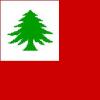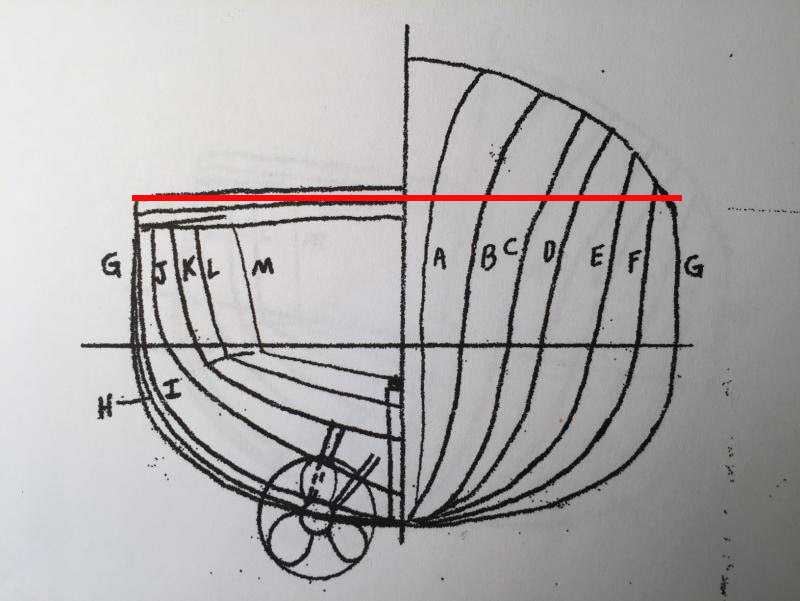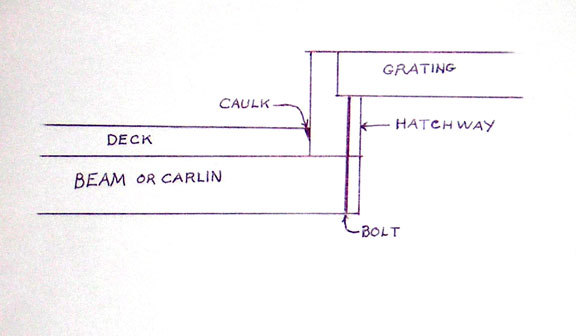-
Posts
1,222 -
Joined
-
Last visited
Content Type
Profiles
Forums
Gallery
Events
Everything posted by jbshan
-

Where is the deck?
jbshan replied to rhephner's topic in CAD and 3D Modelling/Drafting Plans with Software
I didn't want to say so, but the ones Rich is trying to work from look as if they were drawn with a Hershey bar, as my old professor would have said. -

Where is the deck?
jbshan replied to rhephner's topic in CAD and 3D Modelling/Drafting Plans with Software
Your sketch is pretty rough. Yes, 'G' should be at the same height; if the drawing was more accurate, they would be. 'G' port and 'G' starboard are, after all, the same frame but seen one from forward and the other from aft. I took your sketch and put a waterline on it, at the deck edge. They aren't that far apart. What is further making things seem uneven is that this hull has a lot of sheer forward, not as much aft. It rises up at the bows and gets lower until about midship, then staying roughly the same level until the stern. -
You could have a 'log rail' which basically keeps you from sliding overboard, but probably isn't more than a 4X4. You might see it called a 'toe rail' on a modern recreational vessel.
- 362 replies
-
- active
- revenue cutter
-
(and 1 more)
Tagged with:
-
You could go with a short bulwark with railing, but the no bulwark and railing was not uncommon, I believe. They wanted to keep the weight down, especially higher up. It's a pretty small vessel, the effect of topside weight would be exaggerated. Even a short bulwark would hold water as well, producing more weight when you least want it, in a storm.
- 362 replies
-
- active
- revenue cutter
-
(and 1 more)
Tagged with:
-
There is some variation there. Perhaps the OCD kicking in preventing you from seeing it. Haliburton has a good idea to try.
-
Just keep on a plankin', Mike. Try to keep the variations going, too. Grab a few full length ones of different colors and make sure to switch back n' forth from plank to plank.
-
If the deck edge seems a nice fair curve, perhaps the solution is to pad out where needed on the bulkheads to match the deck edge. Add a shape like this: (( to the bulkhead and sand back to get a nice curve.
-
I was gonna suggest it was a chunk of 2X6 with instructions to carve away everything that didn't look like the Miss Molly, but I guess you've already put out the answer.
-
Some folks do the lanyard, the line that is used to tighten the two deadeyes to each other, in lighter, non-tarred line as it is not fixed in place but is adjustable hence 'running' rigging. I personally think it should be 'dirty' at the least from the tar used on the shrouds getting onto the lanyards, and to keep them from looking quite so starkly white.
-
Frankie, that would be a test card or perhaps standard color card. There is one for B&W also. The idea is you would match the color on the print to the actual card. My cheapo photo software has a feature where you can pick a spot on a photo and make it white, gray or black. This would be one purpose for including a piece of paper, though the test card has a gray scale also.
-
Once an artist puts his/her own spin on an image, it can be hard to get restitution as the new image becomes their work, no matter how much the original artist may resent it. See Andy Warhol and his soup cans, etc.
-
Chuck, there will always be an 'audience' for a bargain. I'm sure everybody knows the jerk who always has managed to buy a stove or a couch or a camera or a model kit that is 'just as good as' the one you bought from a reputable dealer or supplier for a tiny fraction of what you paid. 'Just as good as' doesn't usually include any support, longevity of the product or recognition of the rip off artist they're dealing with. It's part of what makes that individual tick, a need to be seen as a better deal maker than anybody else. All you can do is protect your own product as you have done and hope for the best.
-
You need one or the other, quoin or elevating screw. Since the quoin is used on regular trucked carriages for guns, I suspect which one of those you choose would determine the type of carriage, trucked or sliding. The earliest carronades, 1780 or so, had trunnions and used trucked carriages, the lugged mount, screw and sliding carriage came in later. Also later was the extended muzzle shield, to try to keep from setting the rigging on fire with the muzzle blast, as these had much shorter barrels than normal guns. You can roughly date the carronade by these features. Lavery, 'Arming and Fitting' has a lot on these weapons.
- 362 replies
-
- active
- revenue cutter
-
(and 1 more)
Tagged with:
-

Prince de Neufchatel versus US Brig Syren
jbshan replied to Heronguy's topic in Wood ship model kits
PdN was a real ship and her lines taken off by the Admiralty after her capture, so that is pretty accurate. There is a good set of plans (Smithsonian?) around so you can check the kit against them. Don't know the derivation of Syren info. Neither guns nor carronades look good to my eye, wood quality is not a real issue. You can look around, Bluejacket and Caldercraft both offer castings to replace the lower quality of a kit's offerings. Gun/carronade barrels you need only the size of shot and/or barrel length to order replacements. Wood is usually replaced or supplemented in any case. Either of these vessels will be a long-term project, don't begrudge yourself a few dollars to improve things a bit. -
Maybe a bit, Charlie. I guess they would keep the deck thickness in mind when they were laying out to cut the corner joints.
- 362 replies
-
- active
- revenue cutter
-
(and 1 more)
Tagged with:
-
Congratulations, kudos, atta boy etc. Now get moving on the Niagara.
- 143 replies
-
Marcus, just to expand on your choices, and not to imply anything of the sort could have happened to Anja, a friend of mine was transporting a fairly large model of a small rowing boat and set the model down while he opened the back of the car to load it. He got distracted and failed to load the model before he backed out of the driveway. It took him a few years to get over the trauma.
-
Charlie, Considering the requirements for fastening and caulking, this is what I come up with for the structure of a hatchway. Your 'coaming' would be 'hatchway' in the sketch. If the coaming sits on top of the deck, caulking it would push the two apart. The way I have it, the pressure is against the fasteners instead of along them.
- 362 replies
-
- active
- revenue cutter
-
(and 1 more)
Tagged with:
-
If you want a new build without hammock rails, perhaps an Olds 88 or one of those historic aircraft from Model Expo? If you like the look of the prototype pics, and it works, why not go with that?
- 843 replies
-
- niagara
- model shipways
-
(and 2 more)
Tagged with:
-
I read through the Bratten thesis, what seemed to be the relevant parts, and there is no discussion of the heading either during the battle or as she was found. There are indications that the crew was trying to jettison the waist guns, or perhaps to transfer them to another vessel, and both anchors were found underneath their respective catheads, indicators that she was drifting and about to sink. She was also about 300 yds. south of the island, so traveled some distance from her place in the line, either after recovering her anchors or while sinking in the water column. It seems unlike she would have dragged an anchor that far and have come down almost on top of it, so they must have been catted.
- 30 replies
-
- philadelphia
- diorama
-
(and 3 more)
Tagged with:
-

Red Paint or Red Ochre
jbshan replied to davyboy's topic in Painting, finishing and weathering products and techniques
Chuck, light red IS pink. I have seen a demonstration proving that Hershey bars and oranges are the same color. When mixing paint colors, you can get some interesting results as the product depends on how they got to the base color, which combination of pigments they used. -
Yah, it was probably dark by then, so you can display the model in a darkened room.
- 30 replies
-
- philadelphia
- diorama
-
(and 3 more)
Tagged with:
-
The hammocks in the photo were folded in half, in fact that was the best view I found showing this. The covering flap was usually closed up tight. This particular view showed a bit of one end of the line of hammocks.
- 843 replies
-
- niagara
- model shipways
-
(and 2 more)
Tagged with:
-
Horizontal or diagonal, whichever fits best. An old photo of a US Navy ship (on DANFS, probably) showed the hammocks stowed on a diagonal, in a wooden hammock rail (the wooden closing called berthing, for some reason). I make the hammock rails about 28", in both the sheer plan and the detail view, so 28/64" or 7/16". I have a dial caliper with a fractional scale, in 1/64", which makes this particular model scale easy to measure. If you can't find one, perhaps one of the digital ones will have a fractional scale.
- 843 replies
-
- niagara
- model shipways
-
(and 2 more)
Tagged with:
About us
Modelshipworld - Advancing Ship Modeling through Research
SSL Secured
Your security is important for us so this Website is SSL-Secured
NRG Mailing Address
Nautical Research Guild
237 South Lincoln Street
Westmont IL, 60559-1917
Model Ship World ® and the MSW logo are Registered Trademarks, and belong to the Nautical Research Guild (United States Patent and Trademark Office: No. 6,929,264 & No. 6,929,274, registered Dec. 20, 2022)
Helpful Links
About the NRG
If you enjoy building ship models that are historically accurate as well as beautiful, then The Nautical Research Guild (NRG) is just right for you.
The Guild is a non-profit educational organization whose mission is to “Advance Ship Modeling Through Research”. We provide support to our members in their efforts to raise the quality of their model ships.
The Nautical Research Guild has published our world-renowned quarterly magazine, The Nautical Research Journal, since 1955. The pages of the Journal are full of articles by accomplished ship modelers who show you how they create those exquisite details on their models, and by maritime historians who show you the correct details to build. The Journal is available in both print and digital editions. Go to the NRG web site (www.thenrg.org) to download a complimentary digital copy of the Journal. The NRG also publishes plan sets, books and compilations of back issues of the Journal and the former Ships in Scale and Model Ship Builder magazines.




